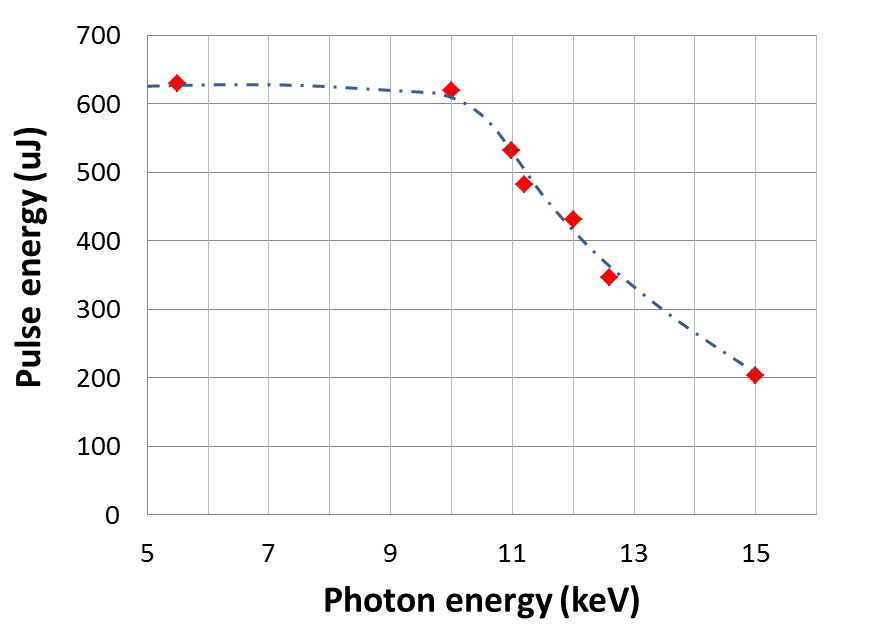
Specifications
Normal operation mode
BL3/BL2 provides hard X-ray FEL produced on the principle of self-amplified spontaneous emission (SASE). Light source parameters in the normal operation mode are summarized in the table below.
| Parameters of light source (BL3) | |
| Electron Beam Energy | 8.5 GeV max. |
| Peak Current | > 10 kA |
| Bunch Charge | 0.2 - 0.3 nC |
| Repetition Rate | 30 Hz (60 Hz max.) |
| Bunch Duration | < 20 fs |
| Normalized Slice Emittance | ~0.4 μm |
| Undulator Period | 18 mm |
| Undulator Parameter | < 2.7 |
| Photon Energy | 4.0 - 20 keV |
| Saturation Power | > 60 GW |
| FEL Pulse Energy (@10 keV) | SASE: > 0.6 mJ Monochromator (Si 111): ~6 μJ |
| Photon Pulse Duration | 2 - 10 fs |
| Energy Band Width ΔE/E (FWHM, @10 keV) | SASE: 0.5% Monochromator (Si 111): 0.01% |
| Beamline Transmittance (@10 keV) | ~70% |
Yabashi et al., J. Synchrotron Rad. 22, 477 (2015).
doi:10.1107/S1600577515004658
Tono et al., J. Synchrotron Rad. 26, 595 (2019).
doi:10.1107/S1600577519001607
Typical values of pulse energy vs. photon energy (BL3)

2-color XFEL (BL3)
The BL3 undulator line is separated into two sections with a magnetic chicane between them for producing two XFEL pulses in different colors by setting independent gap values at each section. The time interval between the two pulses is adjustable with an accuracy of tens of attoseconds by using the magnetic chicane, which delays an electron bunch with respect to the XFEL pulse produced at the first undulator section. The two-color XFEL pulses can be applied to pump-and-prove experiments with high temporal resolution.
(T. Hara et al., Nature Communications 4 (2013) doi: 10.1038/ncomms3919.
Example of the two-color XFEL operation
| 1st Color | 2nd Color | |
| Photon Energy | 13.1 keV | 9.7 keV |
| Pulse Energy | 40 μJ | 40 μJ |
| Maximum Delay | - | 40 fs |
| Photon Energy | 12.2 keV | 9.7 keV |
| Pulse Energy | 50 μJ | 31 μJ |
| Maximum Delay | - | 40 fs |
| Photon Energy | 6.1 keV | 5.9 keV |
| Pulse Energy | 60 μJ | 60 μJ |
| Maximum Delay | - | 80 fs |
Self-seeding (BL3)
A reflection self-seeding system is available at BL3. A bandwidth of self-seeded XFEL can be much narrower than that of SASE XFEL, while an average pulse energy is comparable. A typical setup time for seeded XFEL is 1 shift, which will be included in a user’s beamtime. Please also note that it takes more time to change wavelength of seeded XFEL than in the standard SASE case. Those who plan to use self-seeded XFEL should contact the XFEL Utilization Division (sacla-bl.jasri@spring8.or.jp) in advance of the proposal submission to obtain the detailed information of the operation conditions.
Reference: I. Inoue et al., Nature Photon. 113, 319-323 (2019). doi: 10.1038/s41566-019-0365-y
Typical parameters of seeded-XFEL
| Photon Energy | 7 keV -15 keV |
| Typical Energy Band Width ΔE/E(FHWM) | 0.01 % |
| Typical Pluse Energy | 200 µJ |
Split-and-Delay Optics (BL3)
A split-and-delay optics (SDO), which consists of multiple Si(220) crystals, is available at BL3. An incoming XFEL pulse is split into two parts with an edge-polished crystal as a wavefront splitter. The two pulses are propagated through different paths and recombined onto a nearly common axis with a time separation of up to 100 ps with a femtosecond accuracy. Such ps-delayed monochromatic XFEL pulses can be applied to XFEL pump and XFEL probe experiments and fluctuation measurements in disordered systems.
Reference: T. Hirano et al., J. Synchrotron Rad. 25, 20-25 (2018). doi: 10.1107/S1600577517014023
Typical parameters of double XFEL pulses from SDO
| Photon Energy | 5 keV -15 keV (Si 220) |
| Energy Band Width ΔE/E | 5.6 × 10-5 |
| Pulse Energy (@10 keV) | SASE mode: 0.2 µJ + 0.2 µJ Self-seeding mode: 2 µJ + 2 µJ |
| Maximum Delay | 100 ps |
| Minimum Delay | −10 ps |
